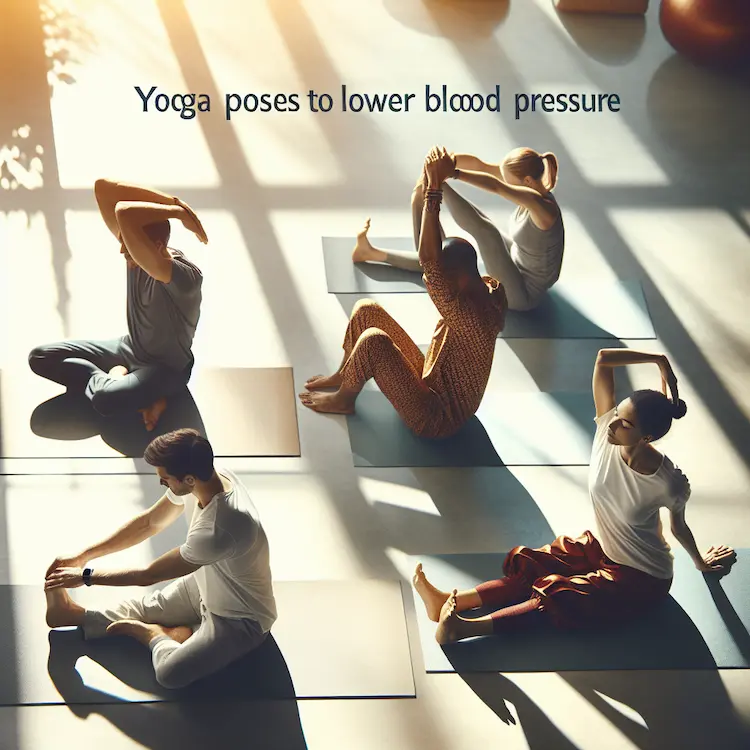High blood pressure, or hypertension, is a significant health concern affecting millions worldwide. While medication is often prescribed, lifestyle changes, including regular exercise and stress reduction techniques, can play a crucial role in managing this condition. Yoga, an ancient practice combining physical postures, breathing exercises, and meditation, has shown promising results in helping to lower blood pressure naturally.
Understanding Hypertension and Yoga’s Role
Hypertension occurs when the force of blood against artery walls is consistently too high. Normal blood pressure is typically below 120/80 mmHg, while readings of 130/80 mmHg or higher are considered hypertensive. Yoga can help manage hypertension through various mechanisms:
- Stress reduction
- Improved circulation
- Enhanced heart health
- Promotion of relaxation

Effective Yoga Poses for Lowering Blood Pressure
1. Shavasana (Corpse Pose)
Shavasana is a deeply relaxing pose that calms the mind and reduces stress, a significant contributor to high blood pressure.
How to practice:
- Lie on your back with legs slightly apart and arms at your sides
- Close your eyes and focus on deep, slow breathing
- Hold for 5-10 minutes
2. Balasana (Child’s Pose)
This gentle pose provides an opportunity for calm and relaxation, preparing the body for deeper practice.
How to practice:
- Kneel on the floor, sitting on your heels
- Bend forward, lowering your chest to your thighs
- Extend your arms forward or alongside your body
- Hold for 1-3 minutes
3. Viparita Karani (Legs Up the Wall Pose)
This inverted pose improves circulation and promotes relaxation, helping to reduce blood pressure.
How to practice:
- Lie on your back with your legs extended up a wall
- Keep your arms relaxed by your sides
- Hold for 5-15 minutes
4. Baddha Konasana (Bound Angle Pose)
This hip-opening pose increases circulation and promotes relaxation.
How to practice:
- Sit with the soles of your feet together, knees bent outward
- Hold your feet with your hands
- Sit up tall and breathe deeply
- Hold for 1-5 minutes
5. Setu Bandhasana (Bridge Pose)
Bridge Pose improves blood flow and can help lower blood pressure.
How to practice:
- Lie on your back with knees bent, feet flat on the floor
- Lift your hips, keeping your shoulders on the ground
- Clasp your hands under your back if comfortable
- Hold for 30-60 seconds
Breathing Exercises (Pranayama) for Blood Pressure Control
Incorporating specific breathing techniques can enhance the blood pressure-lowering effects of yoga.
1. Ujjayi Pranayama (Ocean Breath)
This calming breath technique helps reduce stress and promote relaxation.
How to practice:
- Inhale deeply through your nose
- Exhale slowly through your nose while slightly constricting your throat
- Create a soft, ocean-like sound with each breath
- Practice for 5-10 minutes
2. Extended Exhale Breathing
Lengthening the exhale activates the parasympathetic nervous system, promoting relaxation and lowering blood pressure.
How to practice:
- Inhale for a count of 4
- Exhale for a count of 6-8
- Repeat for 5-10 minutes
Creating a Yoga Routine for Hypertension Management
To effectively use yoga for blood pressure control, consider the following guidelines:
- Practice regularly: Aim for at least 3-5 sessions per week.
- Start slowly: Begin with gentle poses and gradually increase intensity.
- Focus on relaxation: Incorporate restorative poses and breathing exercises.
- Avoid intense inversions: Poses like headstands may temporarily increase blood pressure.
- Listen to your body: Stop if you feel dizzy or uncomfortable.
Comparison of Yoga Styles for Blood Pressure Management
| Yoga Style | Benefits for Blood Pressure | Intensity Level |
|---|---|---|
| Hatha Yoga | Gentle, focuses on basic poses and breathing | Low to Moderate |
| Restorative Yoga | Emphasizes relaxation and stress reduction | Low |
| Iyengar Yoga | Precise alignment, uses props for support | Low to Moderate |
| Hot Yoga | May improve circulation, but caution advised | High |
Additional Lifestyle Factors to Consider
While yoga can be an effective tool for managing blood pressure, it’s essential to adopt a holistic approach:
- Maintain a healthy diet: Reduce sodium intake and increase consumption of fruits and vegetables.
- Exercise regularly: Combine yoga with aerobic activities for optimal results.
- Manage stress: Practice meditation or mindfulness techniques.
- Limit alcohol and quit smoking: Both can contribute to high blood pressure.
- Monitor your blood pressure: Regular check-ups can help track progress.
Conclusion
Incorporating yoga into your daily routine can be a powerful, natural way to manage high blood pressure. By combining physical postures, breathing exercises, and relaxation techniques, yoga offers a holistic approach to cardiovascular health. Remember to consult with your healthcare provider before starting any new exercise regimen, especially if you have pre-existing health conditions.
With consistent practice and a mindful approach, yoga can become an essential part of your strategy for maintaining healthy blood pressure levels and overall well-being.



